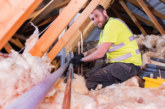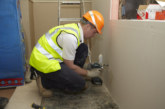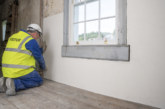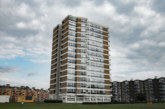Adrian Pargeter, Head of Technical and Product Development at Kingspan Insulation, reveals the hidden cost of ‘cheap’ insulation
The Government’s decision to lift the Housing Revenue Account (HRA) borrowing cap has provided a much-needed boost for local authorities. As work begins to start closing the housing gap, careful consideration needs to be given to delivering quality as well as volume. Often, there is considerable pressure to engage in ‘value engineering’ where specifications are changed to allow the use of cheaper, lower performing materials. When looking at the comparative products in isolation this can appear to provide considerable savings, however, it can also compromise the expected long-term performance of the building or require extensive alterations in the design.
To better understand this issue, Currie & Brown has undertaken extensive research looking at how alterations to the cavity wall insulation specification can affect overall project costs. The analysis shows that by selecting premium performance phenolic insulation over less thermally efficient glass mineral fibre insulation, it is possible to not only reduce external wall depths but also save on overall expenditure.
Cavity requirements
Regulatory guidance on the level of thermal insulation required for new homes is covered within Approved Documents L1A to the Building Regulations 2013 (in England), 2014 (in Wales), and Section 6 (Energy) 2015 of the Building Standards in Scotland. To ensure compliance, it is a good idea to target an external wall U-value of 0.16W/m²·K for properties in England and Wales and 0.15W/m²·K in Scotland.
A key measure of an insulation materials performance is its thermal conductivity (lambda). Products with a lower thermal conductivity are more resistant to heat loss through conduction, meaning a reduced thickness of insulation can be used to achieve a desired level of thermal performance.
Cheaper materials often have relatively high thermal conductivities. For example, glass mineral fibre insulation typically achieves values of between 0.032-0.037W/m·K. In contrast, the latest phenolic insulation boards can achieve a thermal conductivity of 0.018W/m·K. As such, whilst these boards are more expensive than lower performing materials, they can enable target U-values to be reached using thinner insulation, reducing external wall construction depths.
To understand how this may impact overall project costs, Kingspan Insulation commissioned Currie & Brown to carry out an analysis.
Research
To assess how the choice of insulation could impact overall project costs, Currie & Brown developed scenarios for properties of three different scales:
• Large detached house;
• Small detached house; and
• Mid-terraced house.
Each property was modelled using SAP 2012 and was designed to meet the requirements of Approved Document L1A to the Building Regulations 2013 (England). Two external wall constructions with a U-value of 0.16W/m2.K were modelled for each scenario, one with glass mineral fibre insulation and the other with premium performance phenolic insulation. The full specifications are shown in Table 1 (below).
| Specification | Thickness (mm) |
| Brick outer leaf (102.5 mm)
• 100 mm cavity including 90 mm phenolic insulation • 100 mm blockwork inner leaf |
302.5 |
| Brick outer leaf (102.5 mm)
• 180 mm cavity fully filled with glass mineral fibre insulation • 100 mm blockwork inner leaf |
382.5 |
Table 1 – Modelled specifications and overall external wall construction depth.
The cost analysis was then conducted by an experienced residential quantity surveyor.
In addition to the upfront cost of the insulation, the analysis considered a wide range of variables linked to the cavity width and overall thickness of the external walls including the length of wall ties, rafters and joists, width of cavity closers and the extent of foundations.
In all scenarios, foundations are 300mm deep in a 600mm trench. It was assumed that the thinner cavity for the phenolic insulation specification would allow a narrower foundation of 650mm compared with 900mm for the glass mineral fibre specification.

Results
The analysis showed that whilst the cost of the glass mineral fibre insulation itself was less than the phenolic insulation, the increased cavity width with the glass mineral fibre specification raised the cost of all accessories such as lintels, wall ties and cavity closers. Furthermore, the need for more extensive foundations and associated groundworks, along with the additional roof and wall areas, also added significantly to the overall cost of the glass mineral fibre construction.
When all these factors were considered, the analysis showed that the overall cost for the large and small detached houses with the phenolic insulation specification and 600mm foundation was actually less than that of the glass mineral fibre specification with a 900mm foundation (as shown in Table 2 below). Meanwhile, for the mid-terraced property, the cost differential was negligible.
| House Type | 100 mm cavity phenolic insulation specification with 600 mm foundation | 180 mm glass mineral fibre specification with 900 mm foundation |
| Large detached | £53,993 | £54,154 (+£161) |
| Small detached | £41,324 | £41,744 (+£420) |
| Mid-terraced | £9,801 | £9,797 (-£4) |
Table 2 – Summary of results
In addition to these cost benefits, the reduced construction thickness of the phenolic insulation specification should also allow window reveal depths to be minimised. Research has shown this can allow more light into internal spaces and may make them healthier and more attractive to tenants.
Seeing the full picture
With considerable new resources now available for housebuilding, the focus for all local authorities must be to deliver both quality and value — ensuring these homes keep occupants healthy and comfortable over the long-term. The Currie & Brown research highlights the importance of taking a holistic view when approaching specification for the projects. By utilising higher performing materials such as phenolic cavity wall insulation, it may be possible to improve their overall design whilst still saving money.









